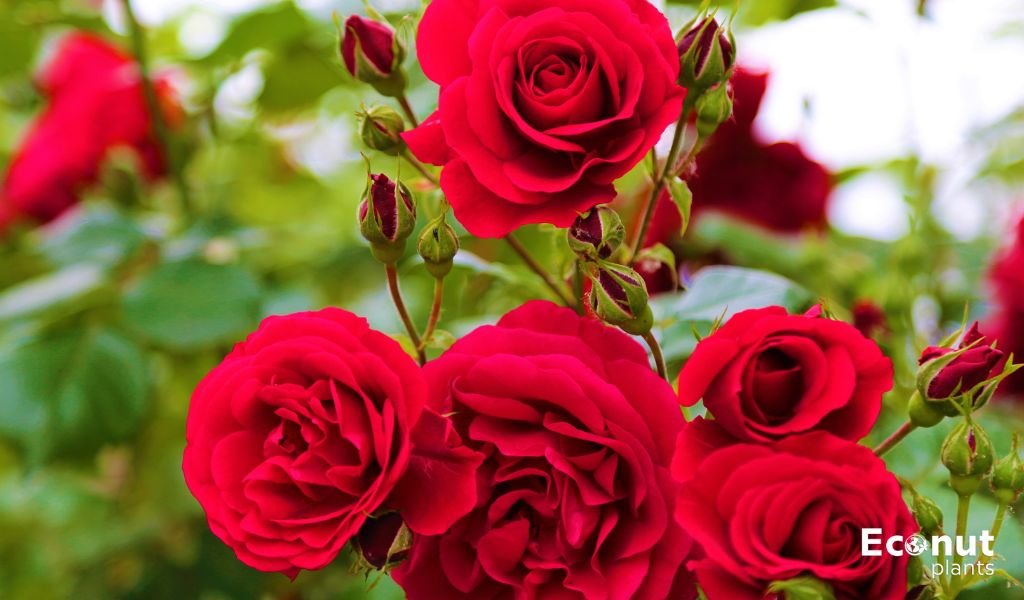Red is a colour that appears most frequently in flowers and other natural objects. However, you may need to determine which flowers look best in your house or garden.
In this article, we examine 65 of our top choices for adding some extra colour that goes with almost every look!
1. Red Dahlia
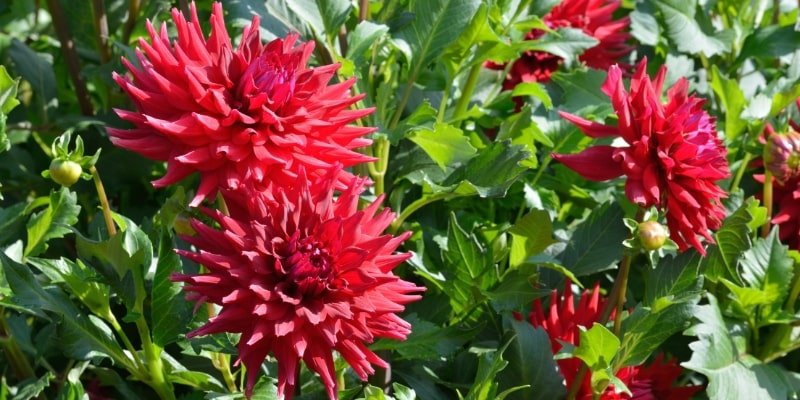 Botanical Name: Dahlia coccinea
Botanical Name: Dahlia coccinea
Growing Zones: 7-10
Sunlight: Full sun
The plant family Asteraceae includes dahlias, which are indigenous to Mexico. Some people refer to them as asters, daisies, and composite plants. This type of dahlia is often called red dahlia, while some of its cultivars can also bloom in orange or yellow.
Traditionally, the Aztec people would frequently consume this plant’s highly nutritious tuberous roots. Today, the vivid, colourful blossoms of red dahlias are mostly appreciated for their ornamental value.
2. Bleeding Hearts
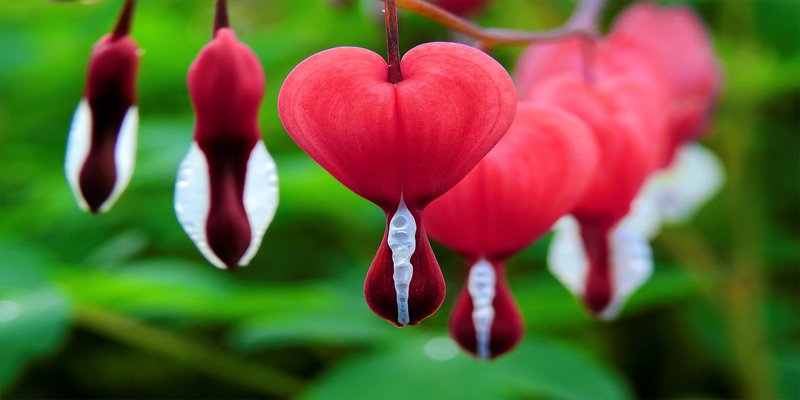 Botanical Name: Lamprocapnos spectabilis
Botanical Name: Lamprocapnos spectabilis
Growing Zones: 3-9
Sunlight: Full Sun to Part shade
The shrub-like, flowering plant Lamprocapnos spectabilis is indigenous to Siberia, northern China, Korea, Japan, and other regions. It is a wider Papaveraceae (poppy) plant family member, specifically the Fumarioideae subfamily.
Formerly, this plant was assigned to the Dicentra plant genus. Although the plant’s official classification has been altered, Dictra spectabilis, its original scientific name, is still recognized as a synonym for the plant.
The candy-red, heart-shaped flowers of the Dicentra spectabilis ‘Valentine’ type of bleeding hearts are a notable feature of the shrub.
3. Blanket Flower
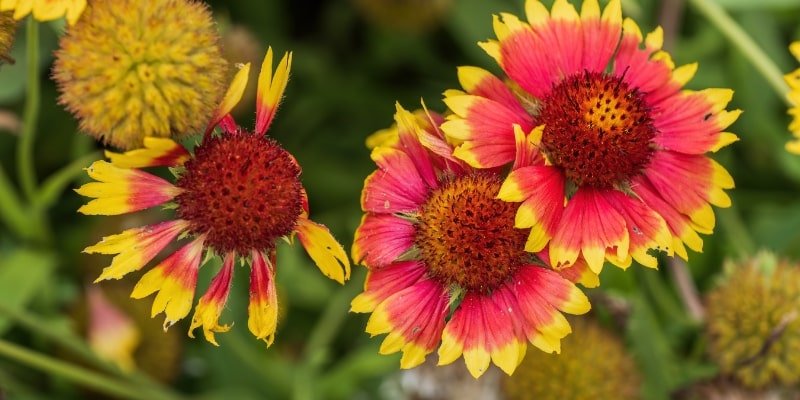 Botanical Name: Gaillardia
Botanical Name: Gaillardia
Growing Zones: 3-10
Sunlight: Full sun
Known by most as blanket flowers, the genus Gaillardia contains over 25 species and subspecies of shrubby flowering plants that are members of the Asteraceae family of plants. They have a great deal of symbolic importance and are indigenous to both North and South America.
Their flower heads include ray florets with an eye-catching colour gradient radiating from the purplish-brown center, which changes from red to orange to yellow, giving them a warm, sunset-like appearance.
4. Begonia
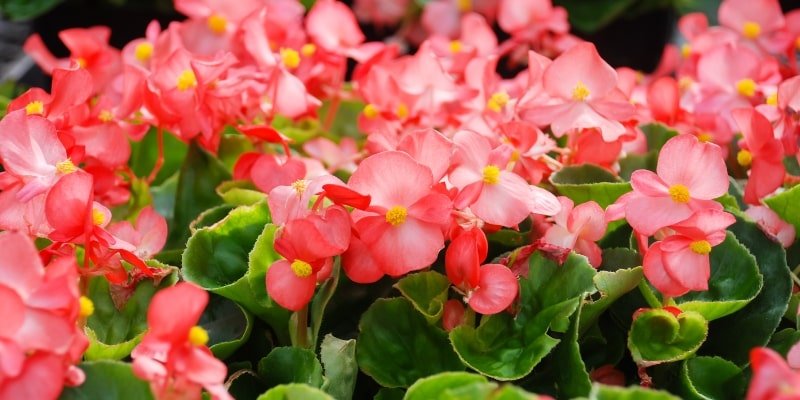 Botanical Name: Begonia
Botanical Name: Begonia
Growing Zones: 6-11
Sunlight: Partial shade to bright indirect light
The plant family Begoniaceae contains two genera: Begonia and Begoniaceae. The Begonia genus includes over 2,000 blooming perennials indigenous to tropical and subtropical regions worldwide.
Begonias come in various varieties widely grown for indoor and outdoor use, and their looks differ significantly. They produce eye-catching, colourful flower flowers in a range of hues, including red, and their foliage can be as smooth and glossy as fuzzy, as well as deep green, deep burgundy, or red.
5. Amaranth
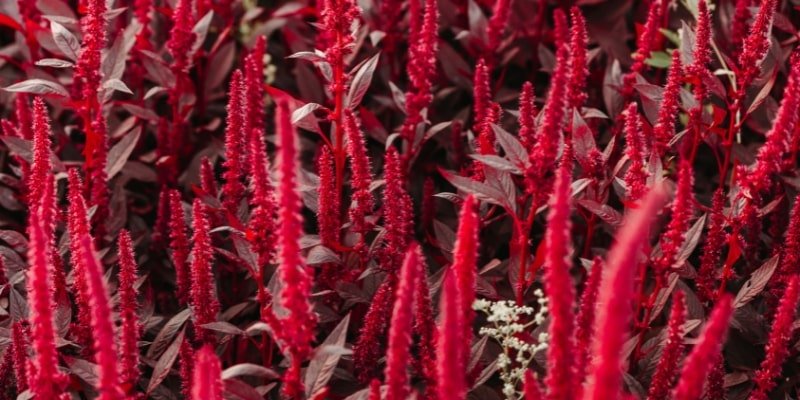 Botanical Name: Amaranthus
Botanical Name: Amaranthus
Growing Zones: 2-11
Sunlight: Full sun
The Amaranthus genus comprises flowering perennial shrubs or plants that yield a broad diversity of flower kinds. It is a member of the Amaranthaceae plant family. These plants belong to a cosmopolitan genus, meaning the entire planet is their native area.
Different species grow amaranth for many purposes. Some are planted for their very nutritious grains and gorgeous, drooping flower clusters. In contrast, others are grown for their ability to make colours or culinary and nutritional benefits.
6. Hollyhock
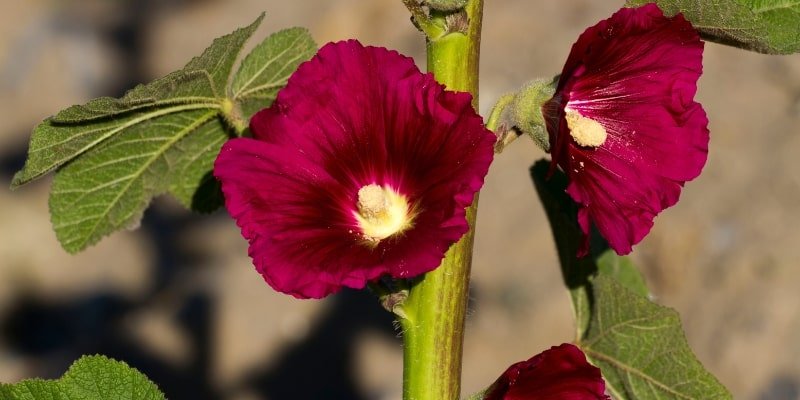 Botanical Name: Alcea
Botanical Name: Alcea
Growing Zones: 3-8
Sunlight: Full sun
The Alcea genus is home to more than 80 species of flowering plants, often referred to as hollyhocks. It is a member of the Malvaceae (mallow) plant family and is comprised of only natural species found in Europe and Asia. The colours of hollyhocks’ blooms are diverse.
Depending on the species, they provide tall, robust stalks adorned with racemes of big, bowl-shaped blooms with varying petal shapes. They bloom in every hue under the rainbow, including red.
7. Cockscomb
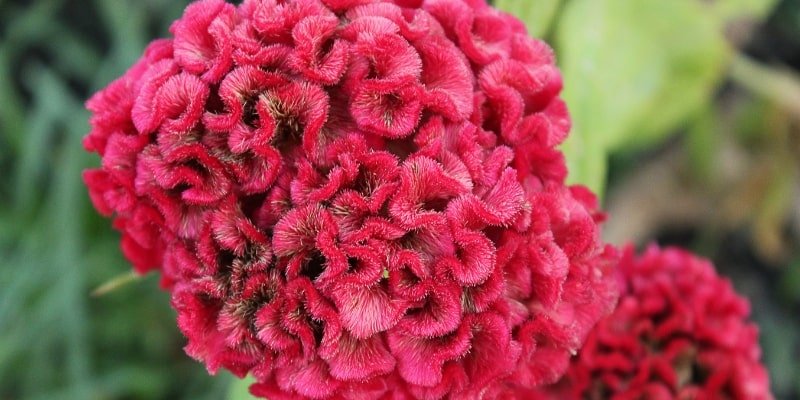 Botanical Name: Celosia argentea var. cristata
Botanical Name: Celosia argentea var. cristata
Growing Zones: 2-11
Sunlight: Full sun
The Celosia genus is native to tropical regions of Africa and includes leafy greens valued for their nutritional content and aesthetic appeal. It is part of the Amaranthaceae plant family.
The genus name originates from the word “flame” (kḗleos) in ancient Greek. This has to do with the flower heads of the plants, which are primarily shaped like flames, while some have a flatter or more spherical form. Vibrant hues such as red, fuchsia, yellow, and orange are displayed in their bloom.
8. Scarlet Beebalm
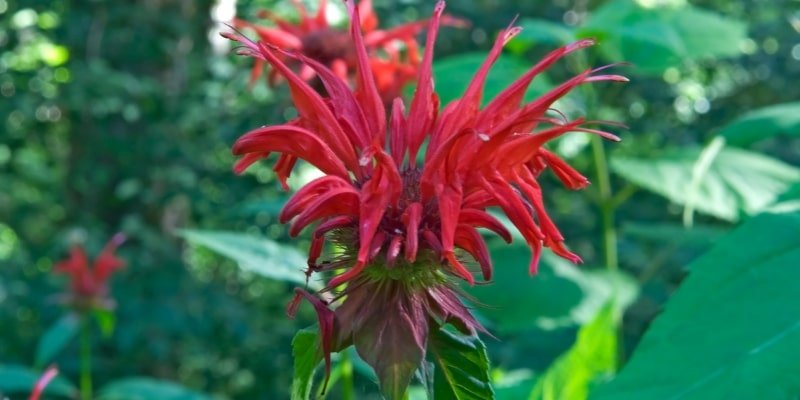 Botanical Name: Monarda didyma
Botanical Name: Monarda didyma
Growing Zones: 4-9
Sunlight: Full sun to partial shade
Monarda didyma is a species of scented flowering herb native to eastern North America, extending from Maine to Ontario. It’s in the plant family Lamiaceae, which includes mint and sage. Because of their tubular petals, they yield strangely shaped blooms that draw different pollinators.
Scarlet beebalm blossoms have a pleasant, citrusy scent that is frequently likened to that of bergamot oranges. Due to its antibacterial qualities, the plant has been used in herbal medicine to treat various infections through tea and poultices.
9. Red Aster
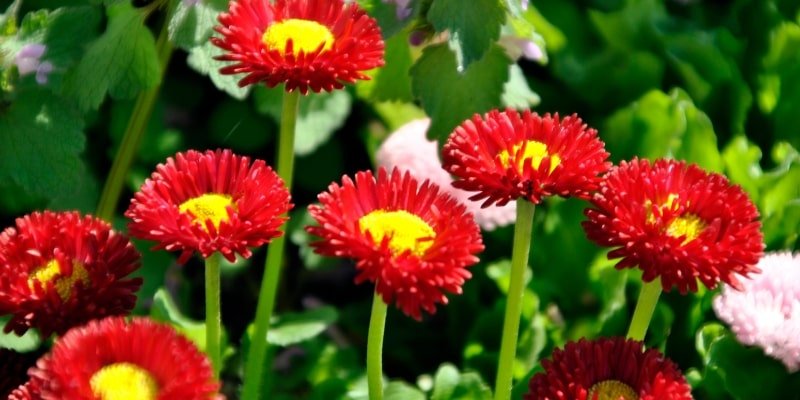 Botanical Name: Aster novae-angliae ‘KICKIN Carmine Red’
Botanical Name: Aster novae-angliae ‘KICKIN Carmine Red’
Growing Zones: 4-8
Sunlight: Full sun
The red aster is a cultivar of the plant family Astereae, specifically Symphyotrichum novae-angliae (previously Aster novae-angliae). Known by most names as the New England aster, this plant is indigenous to much of the eastern and middle-west regions of the United States and Canada.
Asters typically have purple or amethyst-coloured petals, but this cultivar has been cultivated to have reddish-coloured petals instead. With their abundant blooms in late summer and early fall, KICKIN Carmine Birds and butterflies are drawn to red aster flowers.
10. Chocolate Cosmos
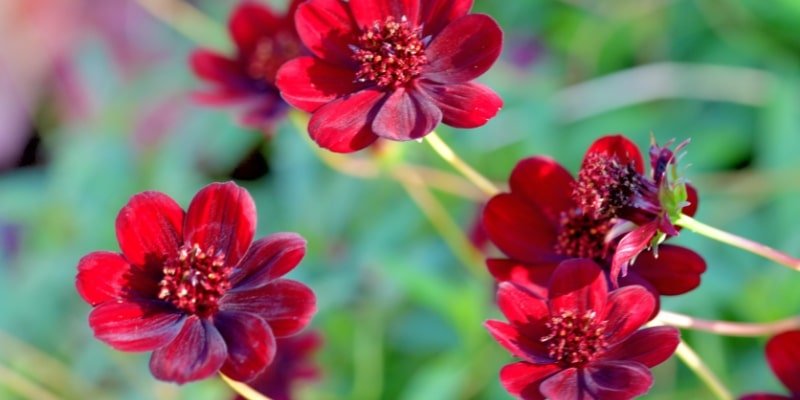 Botanical Name: Cosmos serosanguineous
Botanical Name: Cosmos serosanguineous
Growing Zones: 7-10
Sunlight: Full sun
One of several Cosmos genus species, an herbaceous perennial plant in the Asteraceae family, is Cosmos astrosanguineus. This kind of cosmos flower has maroon, almost brown centers and crimson petals. This flower, often known as the “chocolate cosmos,” has a pleasant aroma similar to that of chocolate.
11. Vervain
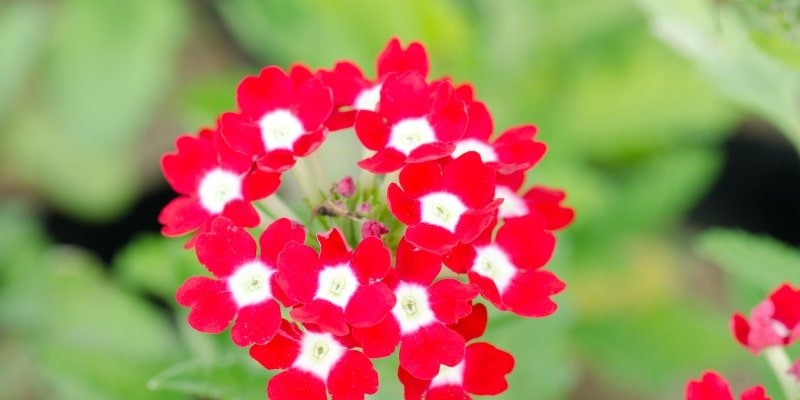 Botanical Name: Verbena peruviana
Botanical Name: Verbena peruviana
Growing Zones: 7-10
Sunlight: Full sun
Verbena peruviana is a species of vervain in the Verbenaceae plant family. It is known for its clusters of scarlet-red flowers, which attract hummingbirds and butterflies in large numbers. This perennial species thrives as a flowering ground cover.
Interestingly, Verbena peruviana, despite its technical name, is not native to Peru; instead, it grows natively in northern Argentina, southern Brazil, Bolivia, Uruguay, and Paraguay.
12. Gloxinia
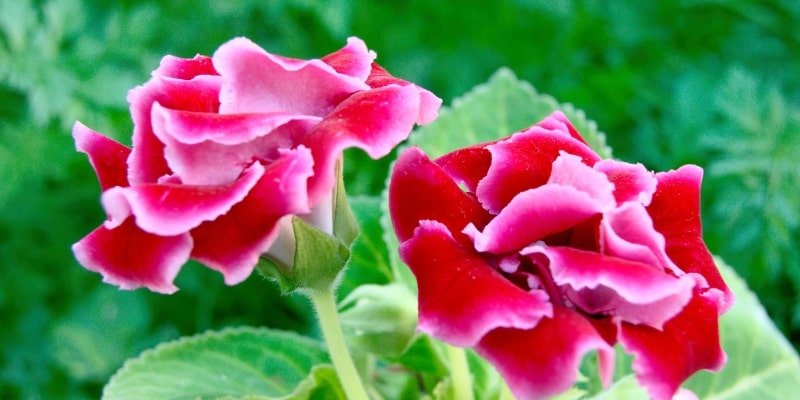 Botanical Name: Sinningia speciosa
Botanical Name: Sinningia speciosa
Growing Zones: 10-11
Sunlight: Bright, indirect light
Gloxinia, a genus of only three herbaceous flowering plants endemic to regions of the Andes, Central America, and the West Indies, is a member of the Gesneriaceae family of plants.
These plants are exquisite ornamentals, with clusters of enormous, trumpet-shaped flowers blooming atop luxuriant rosettes of leaves. The flowers have gently ruffled petals around the edges and can reach a maximum length of 2 inches.
13. Camellia
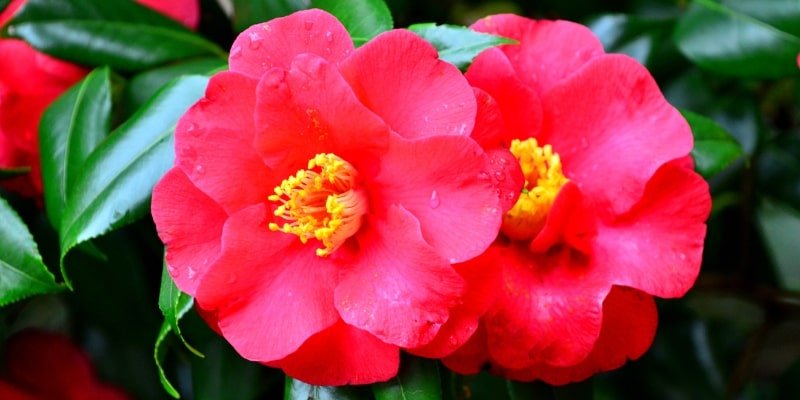 Botanical Name: Camellia
Botanical Name: Camellia
Growing Zones: 7-9
Sunlight: Full Sun to Partial shade
The Camellia genus comprises tiny trees and shrubs with flowers from the Theaceae (tea) plant family. There are between 100 and 300 species in the genus, and the reason for the extensive range in estimated numbers is that the positions of a few species within the genus are currently under dispute.
Camellias have several flower varieties, such as solitary, semi-double, and double, and bloom in red, pink, and white hues. Other variations of the double blossoms include a formal double, anemone, rose, and peony.
14. Maltese cross
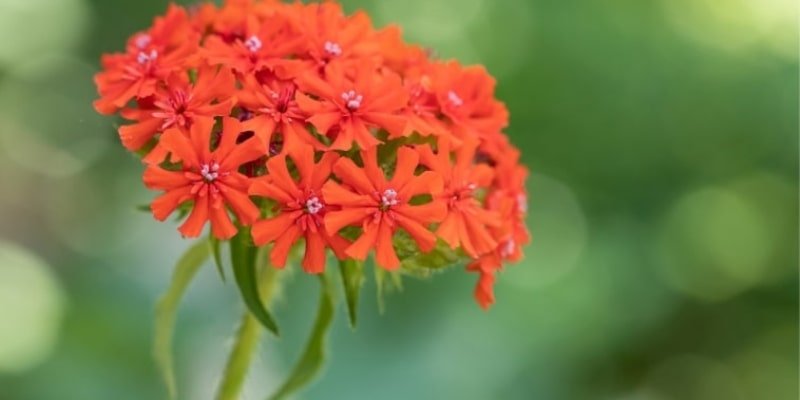 Botanical Name: Silene chalcedonica
Botanical Name: Silene chalcedonica
Growing Zones: 3-7
Sunlight: Full sun
The species Silene chalcedonica is an ornamental flowering plant of the Caryophyllaceae family native to central and western Asia. It has robust, thick stems with globe-shaped clusters of tiny flowers blooming.
The name “Maltese cross” comes from the blooms’ four crimson, v-shaped petals that cross at perpendicular angles, giving the plant its popular name. Jerusalem Cross, the flower of Bristol, Flaming Love, and many more are other frequent names.
15. False Goat’s Beard
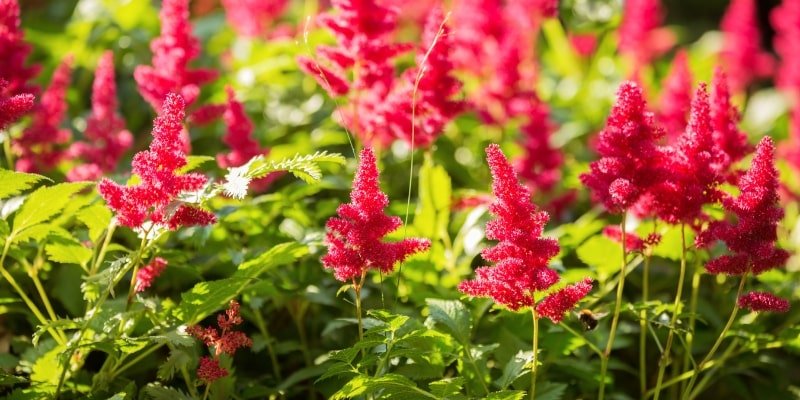 Botanical Name: Astilbe
Botanical Name: Astilbe
Growing Zones: 4-9
Sunlight: Full Sun to Partial shade
Astilbe contains eighteen flowering plants that are members of the Saxifragaceae family. Although native to some regions of Asia and North America, gardens frequently cultivate them for their decorative qualities.
Their foliage is deep green and occasionally resembles ferns. They also have unusually shaped, highly coloured, and fluffy flower flowers. Red Sentinel and “Vision in Red” are two well-liked red variations.
16. Rose
 Botanical Name: Rosa
Botanical Name: Rosa
Growing Zones: 3-10
Sunlight: Full Sun
Red roses are a symbol of passionate love. The Rosa genus, which belongs to the Rosacaea plant family, has over 300 species and tens of thousands of hybrids and cultivars.
This means that when it comes to planting your garden or making a bouquet, there are innumerable red roses in all styles, shapes, and sizes to choose from. Most species are found in Asia, but others are indigenous to Africa, Europe, and North America.
17. Pineapple Sage
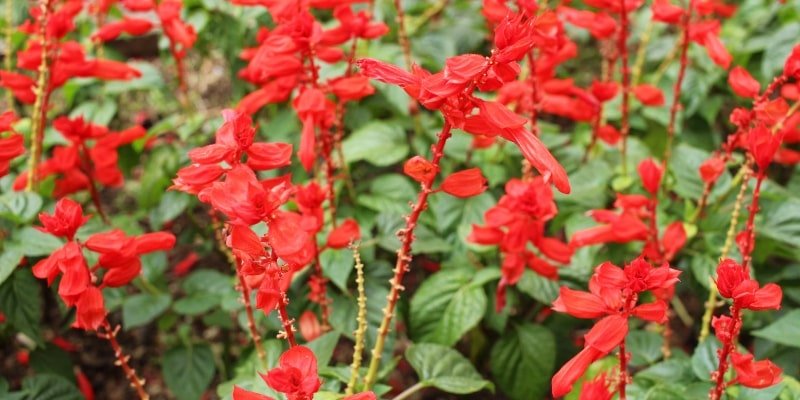 Botanical Name: Salvia elegans
Botanical Name: Salvia elegans
Growing Zones: 8-11
Sunlight: Full sun
Salvia elegans is a herbaceous perennial shrub in the Lamiaceae family native to the high-elevation forests of Mexico.
This salvia species comes in several variations, some of which are pineapple sage, tangerine sage, and honey melon sage, depending on their slightly different scents. Hummingbirds and butterflies are drawn to these shrubs’ brilliant red flowering racemes.
18. Weigela
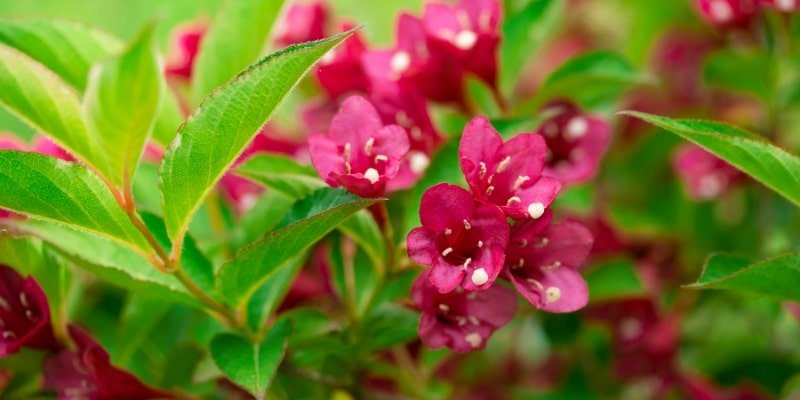 Botanical Name: Weigela
Botanical Name: Weigela
Growing Zones: 4-8
Sunlight: Full sun to partial shade
Weigela is a genus of flowering shrubs in the Caprifoliaceous (honeysuckle) plant family native to eastern Asia. There are currently 12 recognized weigela species.
There could be as many as 38. The plants yield branches that resemble long arms emerging from a starburst. Their leaves are deep green, and the arms are covered in vibrant flower clusters during the flowering season.
19. Nasturtium
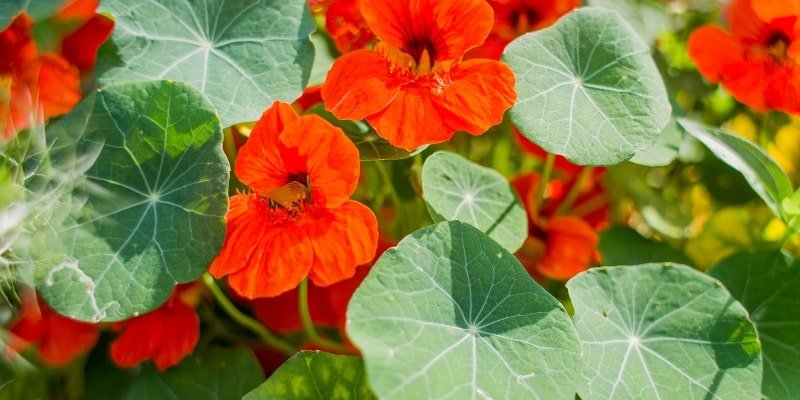 Botanical Name: Tropaeolum
Botanical Name: Tropaeolum
Growing Zones: Annual in most zones
Sunlight: Full sun
Tropaeolum, the sole genus of the Tropaeolaceae plant family, is native to Central and South America and contains roughly 80 species of herbaceous flowering plants. Among them are both annuals and perennials.
The plant’s blossoms have a spicy, watercress-like aroma, which is reflected in its common name, Nasturtium. The translation is “nose twister,” and it is Latin. The foliage of these plants resembles lily pads, while the flowers are elaborate trumpet shapes.
20. Dragon’s Blood Stonecrop
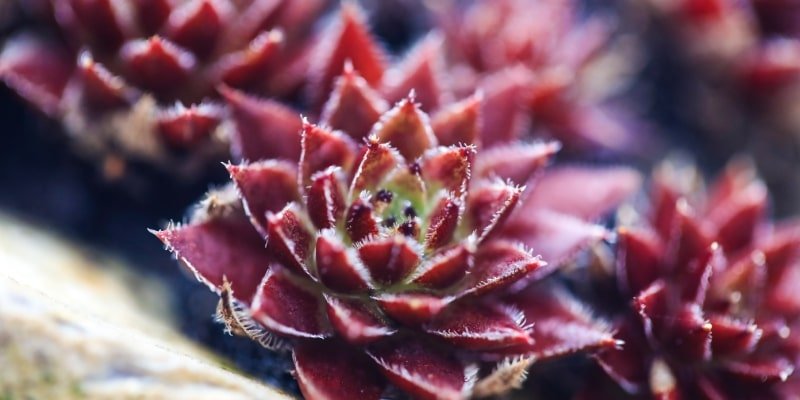 Botanical Name: Sedum spurium ‘Dragon’s Blood’
Botanical Name: Sedum spurium ‘Dragon’s Blood’
Growing Zones: 3-9
Sunlight: Full sun to partial shade
Sedum spurium, often known as Caucasian stonecrop, is a perennial, evergreen, succulent plant native to the Caucasus region of the world. It is a member of the Crassulaceae family of plant families.
It spreads creeper-like, providing a visually appealing ground cover. The’ Dragon’s Blood’ variety produces ruby-red, star-shaped blooms and thick, reddish-green leaf segments.
21. Crepe or Crape Myrtle
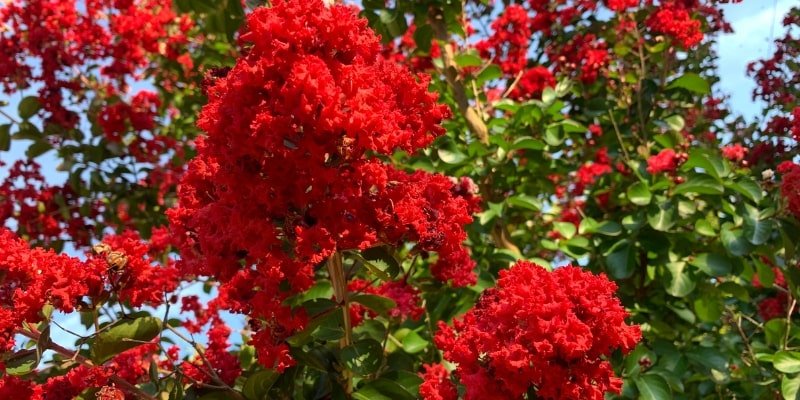 Botanical Name: Lagerstroemia
Botanical Name: Lagerstroemia
Growing Zones: 7-9
Sunlight: Full sun
The genus Lagerstroemia, which includes over 50 species of deciduous and evergreen-blooming trees and shrubs, is a member of the Lythraceae family. Plants belonging to this genus are native to parts of eastern Asia, India, Oceania, and northern Australia.
Due to their extended blooming season, which spans the warmer months, trees and shrubs are frequently planted as ornamentals. When the trees are in full bloom, beautifully coloured clusters of flowers that appear in more excellent colours of red and pink cover them densely.
22. Orchids
 Botanical Name: Orchidaceae
Botanical Name: Orchidaceae
Growing Zones: 6-7
Sunlight: Bright, indirect light
A little over 28,000 species of natural plants from all over the world are recognized as part of the orchid plant family (Orchidaceae). The family comprises 763 distinct genera, including the culinary species Vanilla and well-known ornamental orchids like Phalaenopsis and Dendrobium, which are frequently planted as houseplants.
Among these thousands of different orchid varieties, numerous species, cultivars, and hybrids with flowers in various red colours can be found.
23. African Daisy
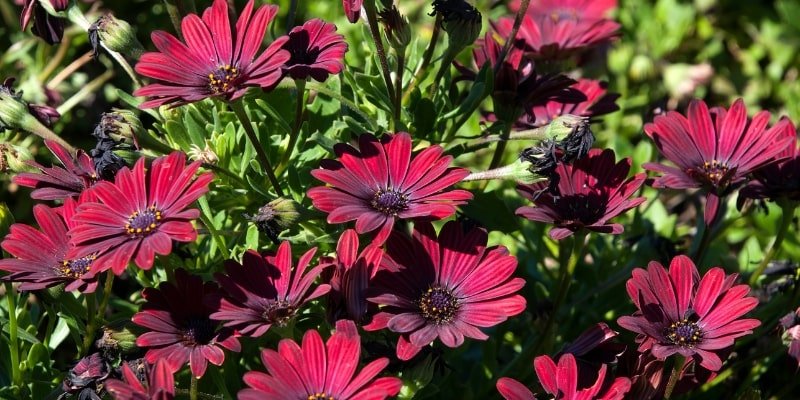 Botanical Name: Gazania
Botanical Name: Gazania
Growing Zones: 9-11
Sunlight: Full sun
Southern African native gazanias are a genus of flowering plants in the Asteraceae family. They produce large, lovely, flat, daisy-like composite flower heads in vivid hues of pink, red, yellow, and orange (standard).
The southern regions of Africa are home to all species of African daisies. They can bloom from spring through autumn if they have access to warm, sunny soil and well-draining conditions.
24. Snapdragon
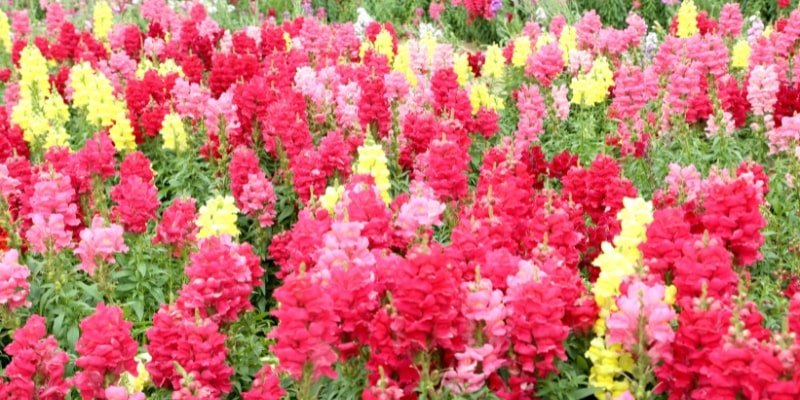 Botanical Name: Antirrhinum
Botanical Name: Antirrhinum
Growing Zones: 7-10
Sunlight: Full sun
Antirrhinum is a genus of flowering plants belonging to the Plantaginaceae (plantain) family. Known by many as snapdragons, these plants have upright flower stalks that resemble the heads of dragons, replete with “jaws” that move up and down in response to lateral pressure.
They naturally grow freely in rocky areas of North Africa, Europe, Canada, and the United States. Growing Snapdragons in rock gardens is a great idea. It’s as easy as scattering their seeds across your stony garden in the spring, giving them water, and watching them flourish.
25. Vesuvius
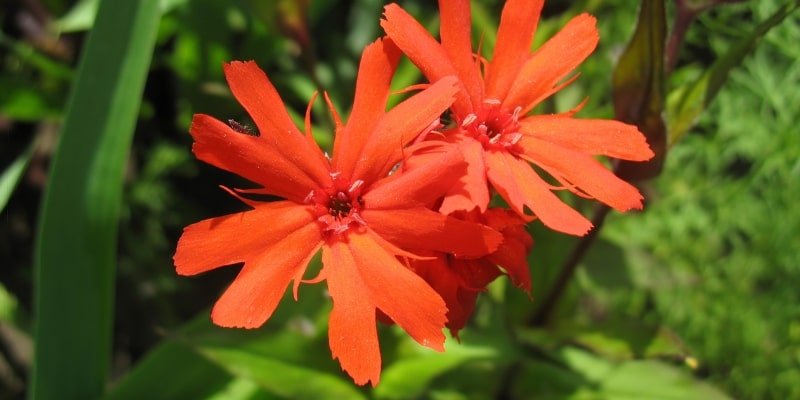 Botanical Name: Lychnis x Arkwrightii ‘Vesuvius’
Botanical Name: Lychnis x Arkwrightii ‘Vesuvius’
Growing Zones: 4-9
Sunlight: Full sun
This plant is a member of the Lychnis genus, which also includes the well-known Maltese cross and rose champion species. The name of the genus, which derives from the ancient Greek word for a lamp, is perhaps a reference to the vividly coloured blossoms of the plant.
The lava-red flowers of the Vesuvius type of Lychnis are a hybrid with a complicated lineage. It is a hybrid of Lychnis chalcedonica and Lychnis x haageana, a hybrid of Lychnis feulgens and Lychnis coronaria v. sieboldii.
26. Petunia
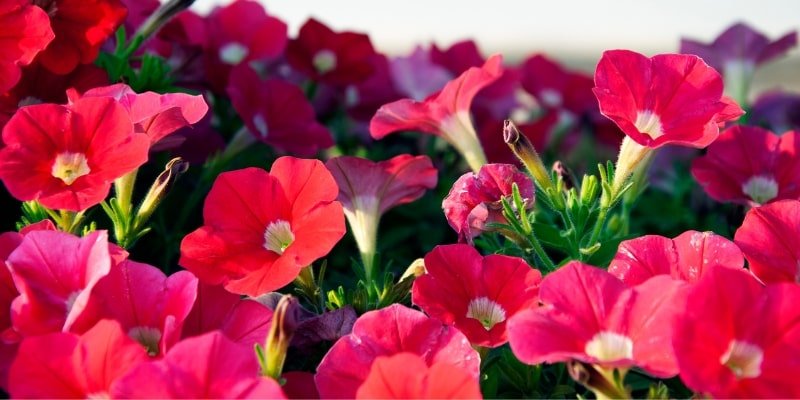 Botanical Name: Petunia
Botanical Name: Petunia
Growing Zones: 9-11
Sunlight: Full sun
Petunia is a genus of perennial flowering plants native to South America. It belongs to the Solanaceae (nightshade) plant family and is very well-liked in gardens. Because of its trailing growth pattern, it thrives perfectly in window boxes and hanging baskets.
Large flowers, vivid colours, and clever colour combinations are the main traits of the majority of petunia species found in gardens, which are actually hybrids and cultivars. As long as you are sincere about your love, red petunia flowers, plants, or seeds are a wonderful gift for your significant other because they represent intensely passionate affection.
27. Freesia
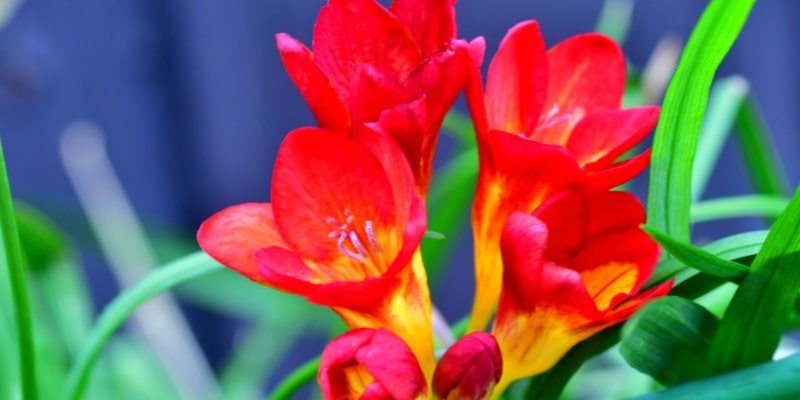 Botanical Name: Freesia
Botanical Name: Freesia
Growing Zones: 9-10
Sunlight: Full sun
Freesia is a genus of perennial flowers in the Iridaceae (iris) plant family, and it’s another fragrant favourite. Although wild freesia flowers are native to southern Africa, they are not like the domesticated hybrids grown in gardens and used to fill bouquets of cut flowers. These are larger, more elaborate flowers in the style of tubes, and they are even grown to have a more pungent scent.
28. Christmas Cactus
 Botanical Name: Schlumbergera
Botanical Name: Schlumbergera
Growing Zones: 10-12
Sunlight: Bright, indirect light
Schlumbergera is a small genus of six to nine-blooming plants native to Brazil’s coastal mountains. It is a member of the Cactaceae (cactus) plant family. The leaf segments of these plants resemble succulents and are waxy, growing in elongated chains. The plants sprout elaborate tubular flowers in red, pink, orange, and white hues from the tips of these stems.
In the Northern Hemisphere, they usually flower in November or December, depending on the species. As a result, people now refer to them as Thanksgiving or Christmas cacti.
29. Wood Lily
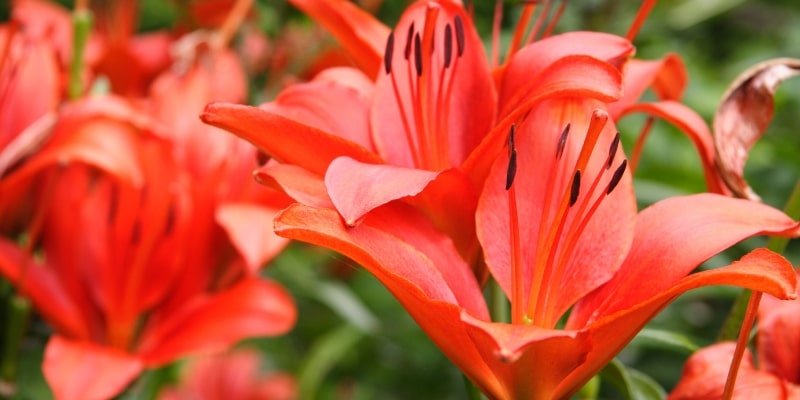 Botanical Name: Lilium philadelphicum
Botanical Name: Lilium philadelphicum
Growing Zones: 4-8
Sunlight: Full sun
A perennial lily in the Liliaceae family is Lilium philadelphicum. Wood lilies are native to most of Canada and the United States and bloom in June and August. Although they grow wild, they are regarded as an endangered species in a number of places.
The blooms have six ovate, black-speckled petals in a stunning orangish-red hue. Its other common names are prairie lily, western red lily, Philadelphia lily, and wood lily.
30. Garden Pansy
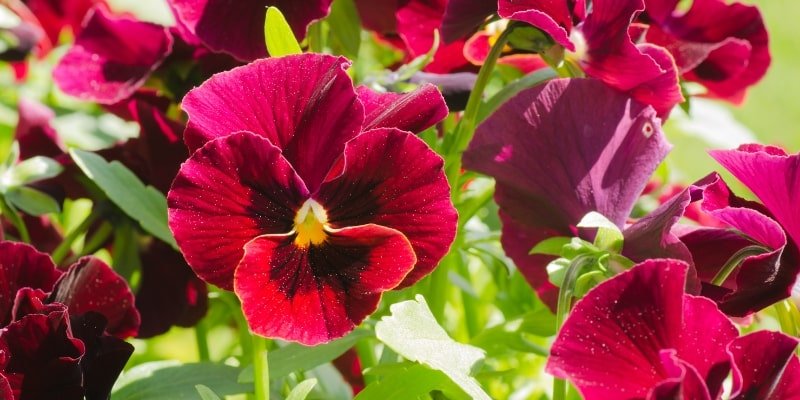 Botanical Name: Viola x wittrockiana
Botanical Name: Viola x wittrockiana
Growing Zones: 6-10
Sunlight: Full sun to partial shade
The genus Viola, which is part of the Violaceae (Viola) plant family, contains a vast group of blooming plants called garden pansies. These plants are all hybridized varieties of flowering plants from the Melanium group. Mostly native to western Asia and Europe, they are their parent flowers.
Plants known as pansies are happy, clumping plants that self-seed and yield flower petals shaped like faces in various colours and combinations, including deep maroon and eye-catching ruby-red.
31. Red Bush Monkeyflower
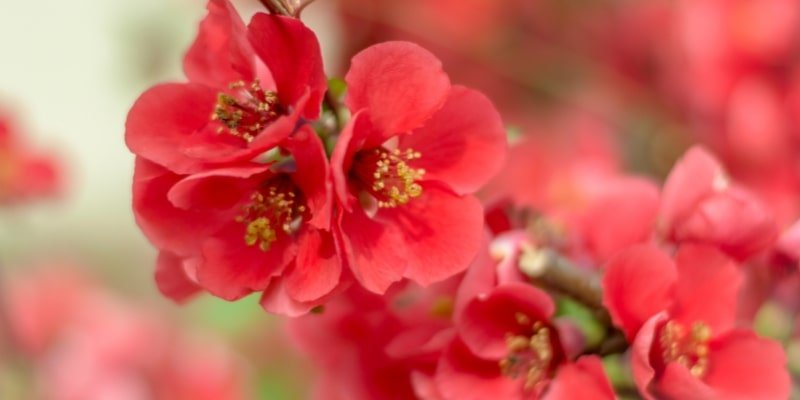 Botanical Name: Diplacus puniceus
Botanical Name: Diplacus puniceus
Growing Zones: 8-10
Sunlight: Full sun to light shade
The Diplacus puniceus, a perennial shrub of the Phrymaceae (lopseed) plant family, is also known by other names, such as red bush monkey flower, mission diplacus, or San Diego monkey flower.
Its reddish-orange flower blooms roughly resemble the face of a monkey. Native to Southern California and Baja California, these evergreen bushes reach heights of approximately two feet in the autumn and three feet in width.
32. Coral Honeysuckle
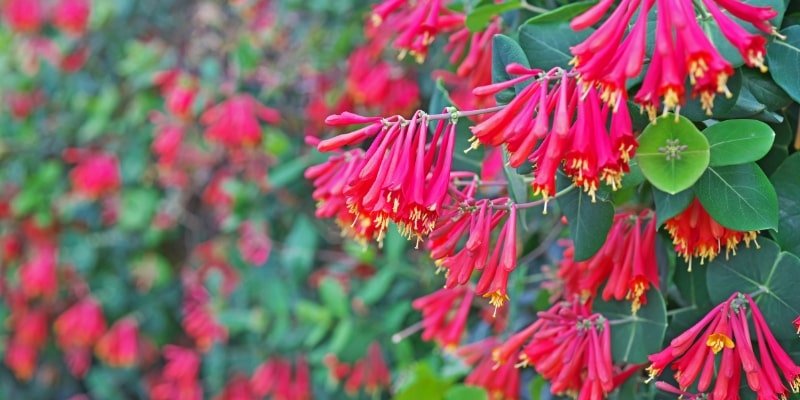 Botanical Name: Lonicera sempervirens
Botanical Name: Lonicera sempervirens
Growing Zones: 4-9
Sunlight: Full sun to partial shade
The species of honeysuckle plant known as Lonicera sempervirens is native to the United States and is a member of the Caprifoliaceous (honeysuckle) plant family. It is also known as the trumpet honeysuckle, the red honeysuckle, or the coral honeysuckle.
The blooming vine attracts butterflies and hummingbirds to pollinator gardens with its delicious aroma. It grows into firework-shaped clusters of thin, red, trumpet-shaped blooms. This is a vine; thus, for it to spread widely, it needs a trellis, fence, or other kind of support. It makes a lovely, fragrant alternative for growing alongside a wall of seclusion.
33. Hibiscus
 Botanical Name: Hibiscus
Botanical Name: Hibiscus
Growing Zones: 5-9
Sunlight: Full sun to partial shade
Hibiscus is a different genus of flowering plants within the Malvaceae family, with hundreds of species. Despite their native range of tropical, subtropical, and temperate regions, hibiscus plants are most often connected to the tropics.
They bear flowers resembling exotic trumpets with conspicuous stamens and fluttery petals. Though they can also bloom in white, pink, and yellow, the blossoms are mainly vivid crimson red in colour.
34. Tickseed
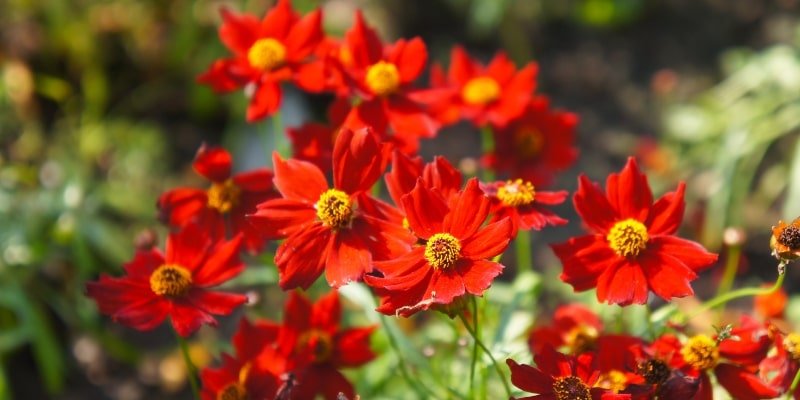 Botanical Name: Coreopsis ‘Red Satin’
Botanical Name: Coreopsis ‘Red Satin’
Growing Zones: 4-9
Sunlight: Full sun
Calliopsis or tickseed are two common names for the flowering plant genus Coreopsis. The genus, part of the plant family Asteraceae, has between 75 and 80 species.
While most tickseed flowers bloom in a vivid golden-yellow, Darrell Probst specifically produced a variety of Coreopsis called “Red Satin,” with satiny petals and a deep red tint. These blossoms draw butterflies and spread swiftly thanks to their rhizomatic, underground root systems.
35. Pineapple Guava
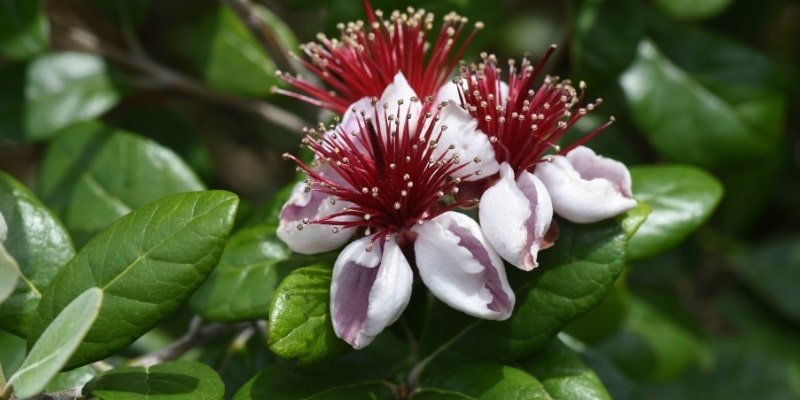 Botanical Name: Feijoa sellowiana
Botanical Name: Feijoa sellowiana
Growing Zones: 8-11
Sunlight: Full sun to partial shade
Feijoa sellowiana is a tiny tree or shrub with flowers that grows in regions of northern South America. Myrtaceae is the family of plants that includes it. Fruits that resemble guavas and are edible give rise to the name pineapple guava.
Desserts such as pies and sorbets frequently contain these fruits. Add them to salads as well. A slightly spicy and sweet flavour profile can be found in the edible flower petals of the pineapple guava.
36. Egyptian Stars
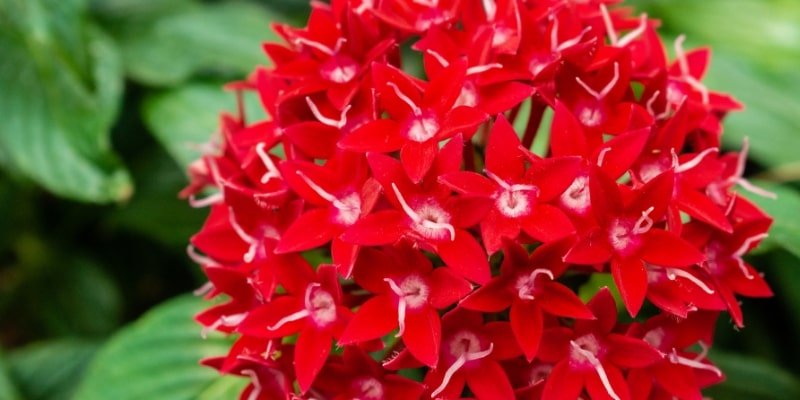 Botanical Name: Pentas lanceolata
Botanical Name: Pentas lanceolata
Growing Zones: 9-11
Sunlight: Full sun
Pentas is a genus of flowering plants in the Rubiaceae family native to tropical parts of Africa, the Arabian Peninsula, Madagascar, and Comoros. It bears flower clusters and is frequently referred to as Egyptian stars. The individual flowers are clearly star-shaped, with five petals each. Varieties bloom in pink, white, purple, and red.
37. Red Sunflower
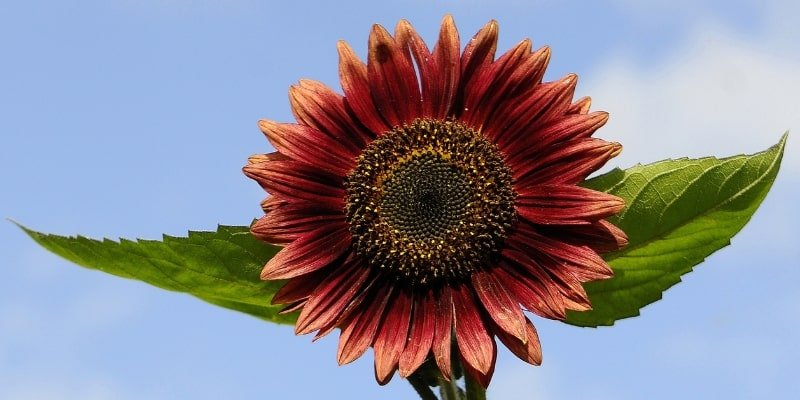 Botanical Name: Helianthus annuus
Botanical Name: Helianthus annuus
Growing Zones: 2-11
Sunlight: Full sun
The plant family Asteraceae includes Helianthus annus, native to the Americas. Known by its common name, the sunflower, this species blooms spontaneously with giant yellow-gold or lemon-coloured flower heads.
Though it has a traditional appearance, the plant has several cultivars and hybrids that bloom in vibrant shades of red, maroon, crimson, and burnt orange. The Prado Red, Red Wave, Ruby Eclipse, Moulin Rouge, and Eclipse are a few of these red variants.
38. Red Trumpet Creeper
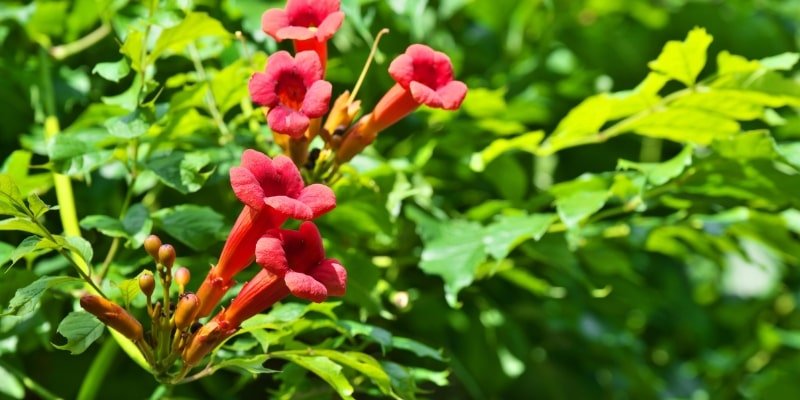 Botanical Name: Campsis radicans
Botanical Name: Campsis radicans
Growing Zones: 4-9
Sunlight: Full sun to partial shade
The flowering vine Campsis radicans is a native of the eastern United States and a member of the Begoniaceae family. The woody, deciduous vine has clusters of distinctive trumpet-shaped blooms that bloom in a cherry-red colour and bright-green foliage. The vine has a maximum length of thirty feet. The terms trumpet vine and trumpet creeper are familiar names.
39. Red Black-Eyed Susan
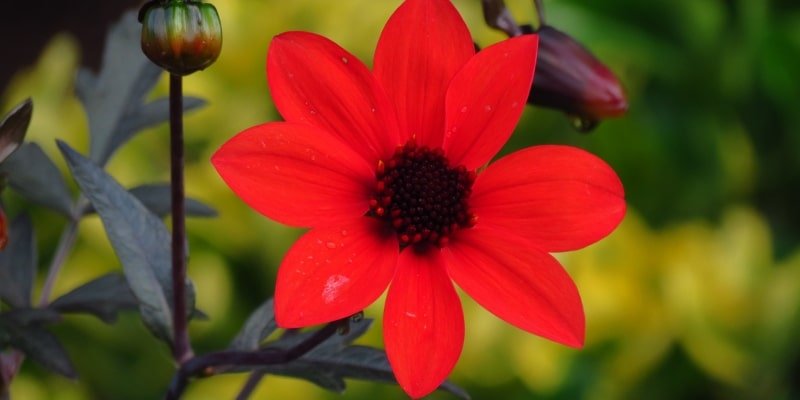 Botanical Name: Rudbeckia hirta ‘Cherry Brandy’
Botanical Name: Rudbeckia hirta ‘Cherry Brandy’
Growing Zones: 3-7
Sunlight: Full sun
The herbaceous perennial Rudbeckia hirta is a native of eastern and central North America and a member of the Asteraceae family. Black-eyed Susans, of course, have dark, brownish, nearly black centers and golden-yellow petals.
In contrast, the Rudbeckia hirta ‘Cherry Brandy’ cultivar has velvety crimson petals encircling a virtually purple center. These gorgeous blooms will draw butterflies for pollination and look cheery in a garden.
40. Poinsettia
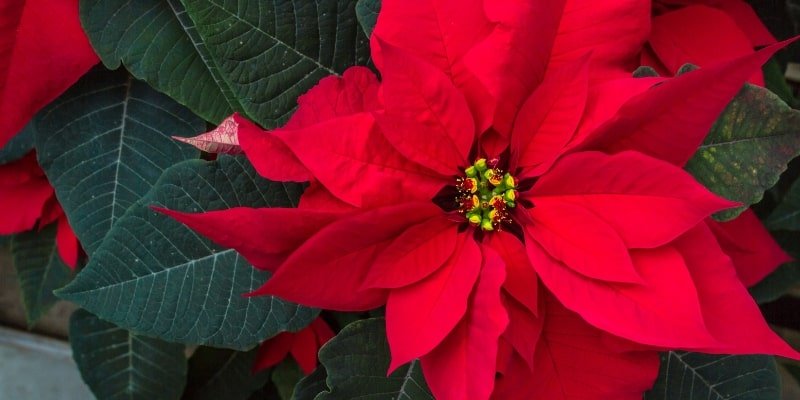 Botanical Name: Euphorbia pulcherrima
Botanical Name: Euphorbia pulcherrima
Growing Zones: 9-11
Sunlight: Full sun to partial shade
Euphorbia pulcherrima is far more widely recognized as the beloved poinsettia plant for the holidays. It is a species of shrub or small tree in the Euphorbiaceae (spurge) family of plants.
Because poinsettia plants are indigenous to Mexico and Central America, they require six hours of robust and indirect sunlight daily. Because of this, keeping your Christmas poinsettia plants flourishing long after the New Year might be challenging, mainly if you reside in a northern location with very few winter days.
41. Gladiolus
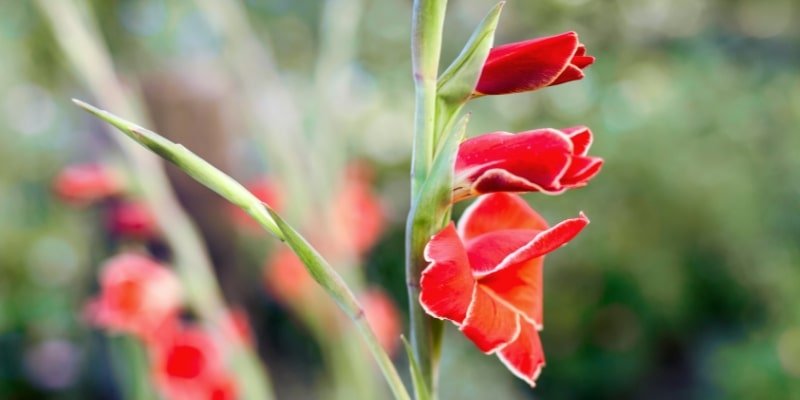 Botanical Name: Gladiolus
Botanical Name: Gladiolus
Growing Zones: 7-10
Sunlight: Full sun
The genus Gladiolus comprises perennial flowers that are a part of the Iridaceae (Iris) plant family. Native to South Africa, Asia, the Mediterranean, and tropical Africa, these plants grow there.
The genus name gladius is derived from the Latin word gladius, which means sword. This name alludes to the plant’s strikingly substantial flower spikes, which bear numerous rows of trumpet-shaped, colourful, and eye-catching blooms. Sword flowers are another name for these flowers, even though the genus name most frequently refers to them.
42. Kalanchoe
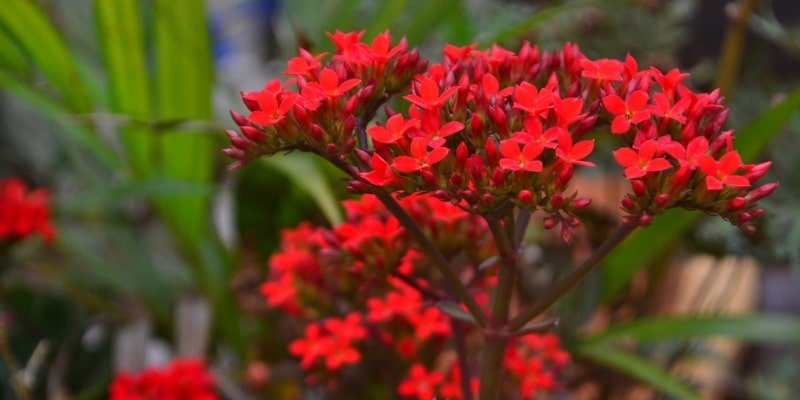 Botanical Name: Kalanchoe
Botanical Name: Kalanchoe
Growing Zones: 10-12
Sunlight: Full sun to partial shade
The genus Kalanchoe, which includes over 125 flowering tropical, perennial, and succulent plants, is native to Madagascar and tropical Africa. It is a member of the Crassulaceae (stonecrop) family of plants.
Kalanchoe leaves are broad and waxy, and they bear small, delicate, tube-shaped flowers in colourful clusters. Kalanchoe plants frequently bloom all year in their natural environments, but they are also frequently grown inside, where they bloom from late winter to early spring.
43. Daylily
 Botanical Name: Hemerocallis
Botanical Name: Hemerocallis
Growing Zones: 3-9
Sunlight: Full sun to partial shade
The Hymenocallis genus of flowers has more than 80,000 recognized daily varieties, all of which are indigenous to eastern Asia. The popular name “daylily” originates from the way many species bloom: early in the morning, blossoms open, spend the night closed and are replaced by new ones by morning.
True lilies and daylily blossoms are similar. However, they are members of the Asphodelaceae family of plants rather than the Liliaceae.
44. Yarrow
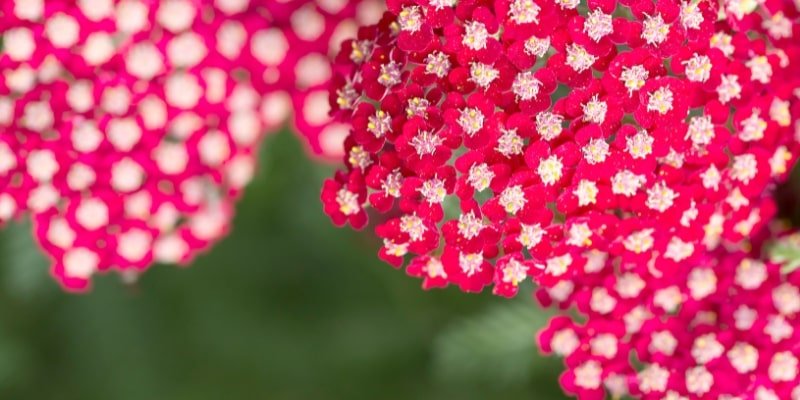 Botanical Name: Achillea millefolium
Botanical Name: Achillea millefolium
Growing Zones: 3-9
Sunlight: Full sun
Achillea millefolium, sometimes known as common yarrow or yarrow, is a herbaceous, perennial, flowering plant of the Asteraceae family. It is indigenous to North America, Europe, and Asia’s temperate zones.
While in bloom, they produce enormous masses of flat-topped flower clusters with delicate ray florets. Though some types include pink or red blossoms, the most prevalent hues are white and yellow. One of the most widely used types of red yarrow is called “Red Velvet.”
45. Cypress Vine
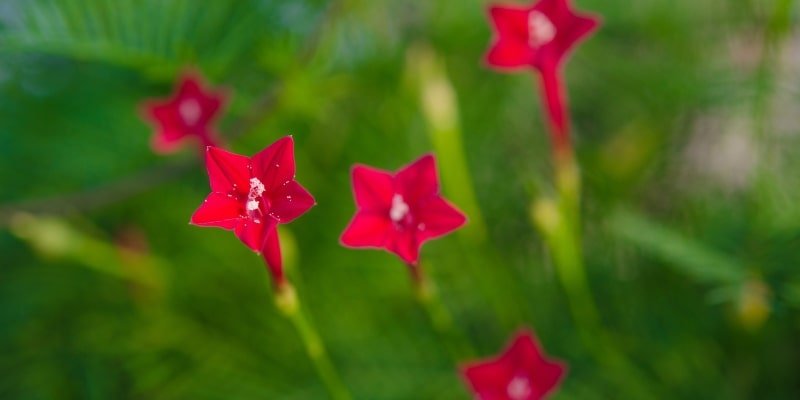 Botanical Name: Ipomoea quamoclit
Botanical Name: Ipomoea quamoclit
Growing Zones: 6-9
Sunlight: Full sun
The flowering vine species Ipomoea quamoclit is native to the tropical parts of the Americas and is a member of the Convolvulaceae (morning glory) family of plants. Several colloquial names, including hummingbird vine, cardinal creeper, star glory, star of Bethlehem, and cypress vine morning glory, also known as the vine.
The vines’ leaves are very slender and pinnately formed, and they bear big, brilliant red trumpet-like blooms that open up into beautiful, five-pointed stars.
46. Columbine
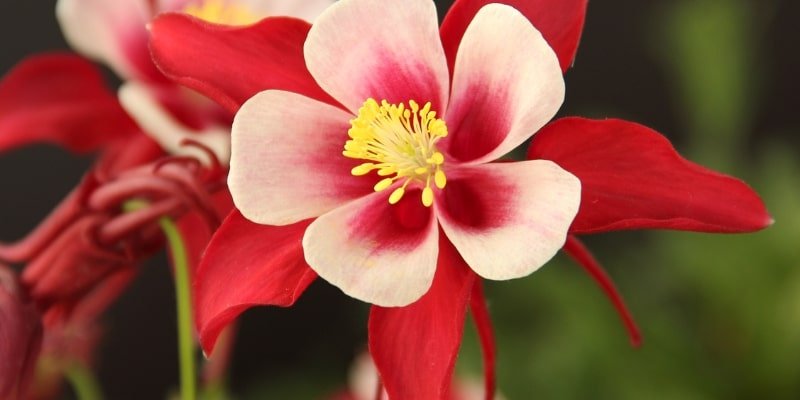 Botanical Name: Aquilegia
Botanical Name: Aquilegia
Growing Zones: 3-9
Sunlight: Full sun to partial shade
Aquilegia is a genus of 60–70 perennial flowers native to higher elevations in the Northern Hemisphere. It is a member of the Ranunculaceae plant family.
These plants have intricate flowers with multiple layers of petals and a row of distinctively spurred petals that virtually instantly identify columbine flowers. In the gorgeous blossoms of hybrids and cultivars meant for ornamental gardening, many different colours can be seen on a single flower.
47. Dianthus
 Botanical Name: Dianthus
Botanical Name: Dianthus
Growing Zones: 3-9
Sunlight: Full sun
The Dianthus genus contains about 340 species of flowering plants belonging to the Caryophyllaceae plant family. These flowers are native to Asia and Europe, but some species are endemic to North America and grow natively in southern and northern Africa.
Though common names for certain particular species include pink, carnation, and sweet William, these plants are usually called by their genus names. Their flowers are typically pink or crimson with five petals and are available in annual and perennial types. Some species with frills, like carnations, exhibit a noticeable increase in petals.
48. Cardinal Flower
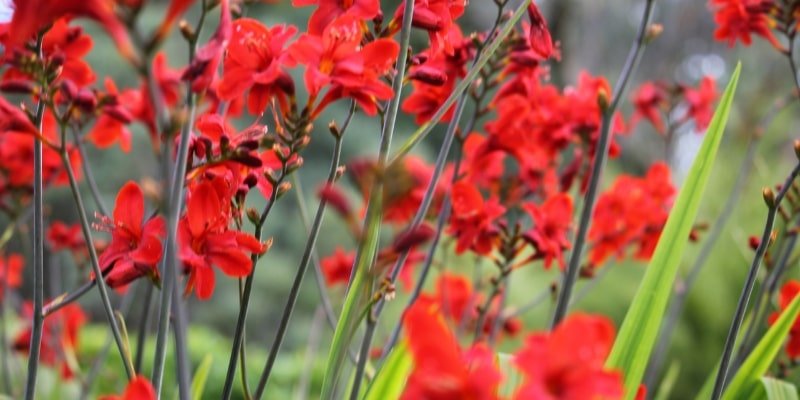 Botanical Name: Lobelia cardinalis
Botanical Name: Lobelia cardinalis
Growing Zones: 3-9
Sunlight: Full sun to partial shade
Lobelia cardinalis is a perennial herbaceous-blooming plant endemic to much of the Americas. It is a member of the Campanulaceae (bellflower) plant family. It needs a lot of moisture, so it is most frequently seen in damp, marshy, or swampy environments.
Cardinal flower lanceolate or ovate leaves are 8 inches long and grow in bunches on high stalks. Racemes of vivid cardinal red, five-lobed flowers sprout from the apex of these spikes.
49. Poppy
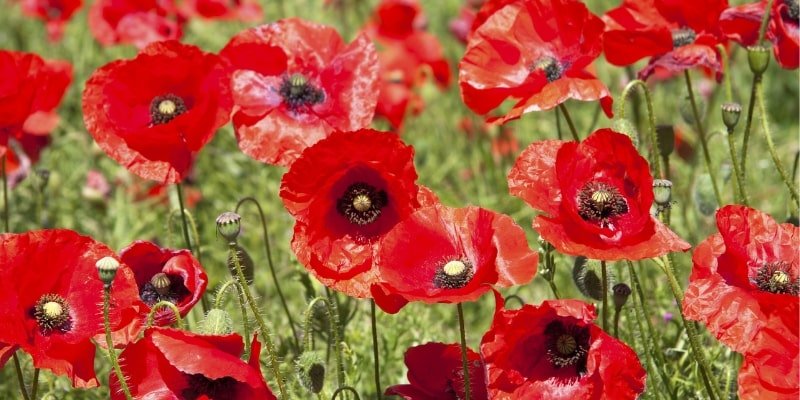 Botanical Name: Papaveroideae
Botanical Name: Papaveroideae
Growing Zones: 2-10
Sunlight: Full sun
Many popular herbaceous blooming plants called poppies belong to the Papaveraceae (poppy) plant family’s subfamily Papavveroideae. Since ancient times, people have harvested and utilized the seeds of various native plants found worldwide for their analgesic effects. These seeds are the source of opium.
Red poppies were planted in Flanders Field during World War I, and they came to represent the memory of the fallen.
50. Zinnia
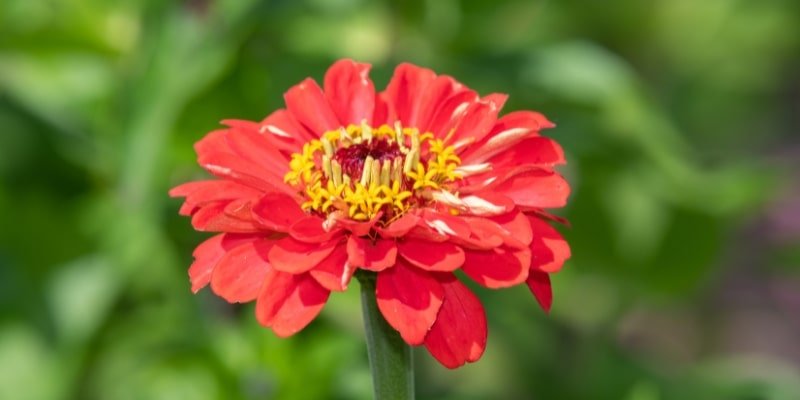 Botanical Name: Zinnia
Botanical Name: Zinnia
Growing Zones: 3-10
Sunlight: Full sun
The Zinnia genus contains just over 20 varieties of zinnia flower species, which are found in both the Heliantheae plant tribe and the Asteraceae plant family. Most species are native to Mexico, extending from the southern United States to South America.
Their stunning flowers come in different forms; some have multiple layers, while others have just one ring of ray flowers or petals. When the blooms mature, many small disc florets open gradually, and the centers of the flowers undergo their own blooming process.
51. Coleus
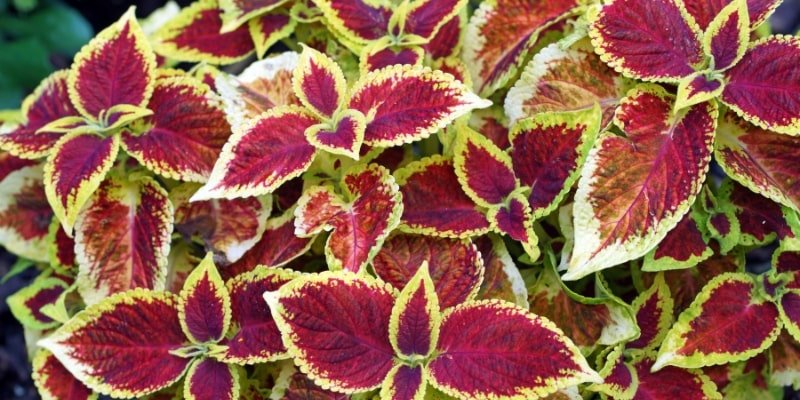 Botanical Name: Coleus
Botanical Name: Coleus
Growing Zones: 10-11
Sunlight: Shade to partial sun
Coleus is a genus of flowering plants native to tropical and subtropical regions of Asia, Europe, and Africa. Depending on the species, these plants can be annual or perennial and have various shapes. The genus is part of the plant family Lamiaceae, which includes sage and mint.
Coleus plants are more prized for their unusually patterned and colourful foliage than for their relatively simple, small, and, to be honest, uninteresting blooms in comparison to the surrounding foliage.
52. Lycoris
 Botanical Name: Lycoris
Botanical Name: Lycoris
Growing Zones: 5-9
Sunlight: Full sun to partial shade
Lycoris is a genus of 12–20 flowering plants in the Amaryllidaceous plant family native to southern and eastern Asia. Its common names in the United States are hurricane lily and cluster amaryllis.
In the United Kingdom, they’re called spider lilies. Clusters of tiny flower stalks support long, slender stems and produce four to eight cherry-red flowers with finger-like petals. Because this genus of flowers is poisonous, use caution when planting them.
53. Marigold
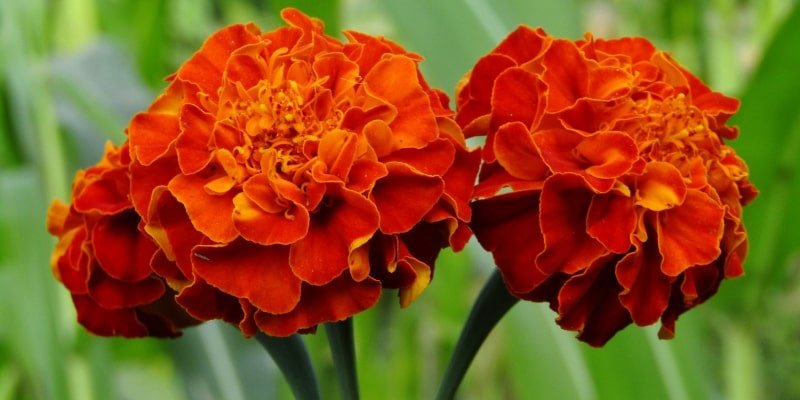 Botanical Name: Tagetes
Botanical Name: Tagetes
Growing Zones: 2-11
Sunlight: Full sun
The genus Tagetes comprises annual and perennial herbaceous flowers in the Asteraceae family. Like zinnias, it is native to South America and the southwestern United States.
The musky aroma of marigolds works wonders at keeping rabbits and deer away. This makes them an excellent option for planting next to vegetable gardens or other plants you want the local wildlife to avoid.
While marigold blooms are usually yellow or golden in hue, several types bloom in crimson, maroon, and deep orange tones. When planted together in a container or yard, their warm, varied hues produce a lovely sunset effect.
54. Red Passion Flower
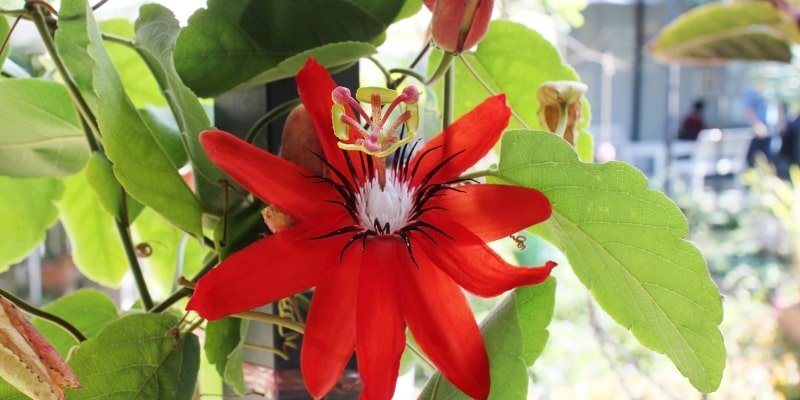 Botanical Name: Passiflora racemosa
Botanical Name: Passiflora racemosa
Growing Zones: 10-11
Sunlight: Full sun to partial shade
Native to Brazil, Passiflora racemosa is a highly ornamental flowering plant in the Passifloraceae family. An evergreen floral vine climbs trees and clings to their bark. Their three lobes give their leaves a shape akin to a dinosaur’s footprint. The intense tint of purple and white corona with crimson striations adorns the pinnate petals of these passion flowers.
55. Azalea
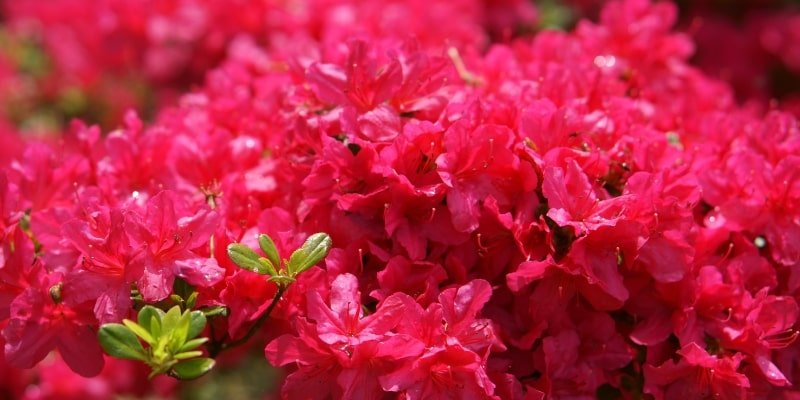 Botanical Name: Azaleastrum
Botanical Name: Azaleastrum
Growing Zones: 5-9
Sunlight: Full Sun to Partial shade
The common name for the plant species in Azaleastrum, a subgenus of the Rhododendron genus and part of the Ericaceae (heather) plant family, is Azalea. There are almost 10,000 varieties.
Azaleas are woody, blooming shrubs profusely with fluttery, papery flowers. While some types are evergreen, others are deciduous. They bloom in vivid pink, red, and white tones. These plants are highly toxic in every way despite their beauty.
56. Chrysanthemum
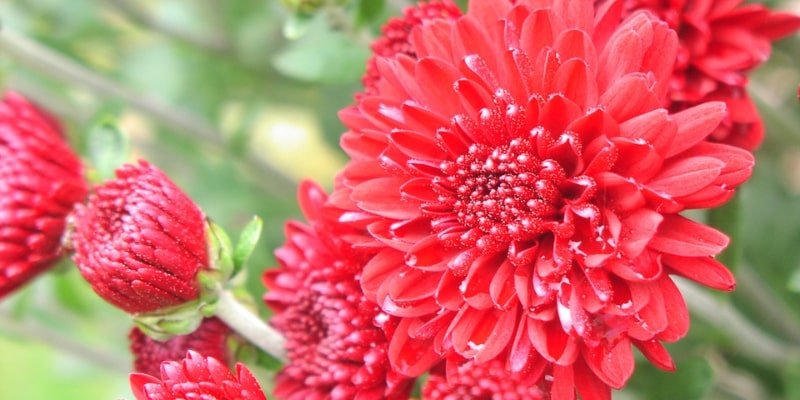 Botanical Name: Chrysanthemum
Botanical Name: Chrysanthemum
Growing Zones: 5-9
Sunlight: Full sun
The Asteraceae family includes the genus Chrysanthemum, herbaceous and blooming perennial plants and subshrubs. While some chrysanthemums are native to northern Europe, most are native to Asia.
Chrysanthemums are some of the most popular flowers to cultivate in gardens, incorporate in floral arrangements, and decorate for holidays throughout the year due to their diversity of variations, colour (including several appealing hues of red), bloom types, forms, and sizes.
My favourite red chrysanthemums include “Cynthia Scarlet,” “Five Alarm Red,” “Autumn Sunset,” and “Grapeberry Red.
57. Carnation
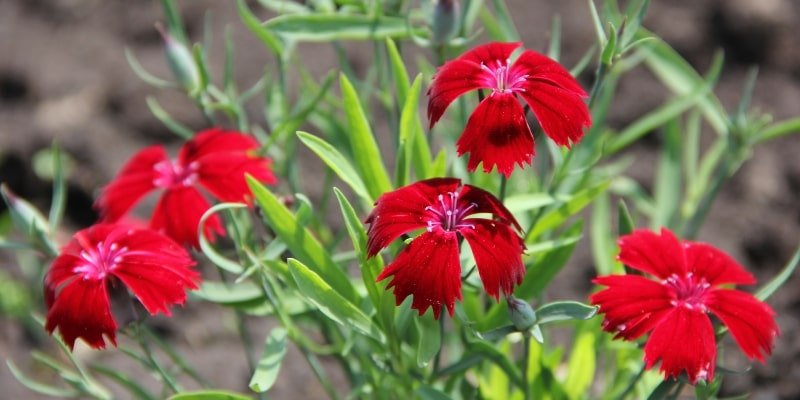 Botanical Name: Dianthus caryophyllus
Botanical Name: Dianthus caryophyllus
Growing Zones: 6-9
Sunlight: Full sun
A species of flowering Caryophyllaceae (carnation or pink) plant family member is Dianthus caryophyllus, also referred to as the clove pink or carnation. Although its origin is difficult to ascertain due to extensive cultivation over thousands of years, carnations are assumed to have originated in the Mediterranean.
Although they certainly have their special meaning, carnations will always be connected to prom corsages. Red carnations have different symbolic meanings depending on the tint, unlike the red rose, which is always associated with romantic love. While softer red hues signify appreciation, darker red symbolizes love and affection.
58. Oleander
 Botanical Name: Nerium oleander
Botanical Name: Nerium oleander
Growing Zones: 8-10
Sunlight: Full sun
The sole species of the genus Nerium oleander is a shrub that can be trimmed to shape it into a tiny tree or grown as a blooming shrub. It bears clusters of five-petaled flowers, which can be pink, white, or red, and has dark green foliage. Oleander flowers all year long, with the longest summer days seeing the most blooms.
Oleander is poisonous to both people and animals and is a member of the dogbane (Apocynaceae) plant family. However, because it tastes sour and disagreeable, poisoning is not common.
59. Pygmy Water Lily
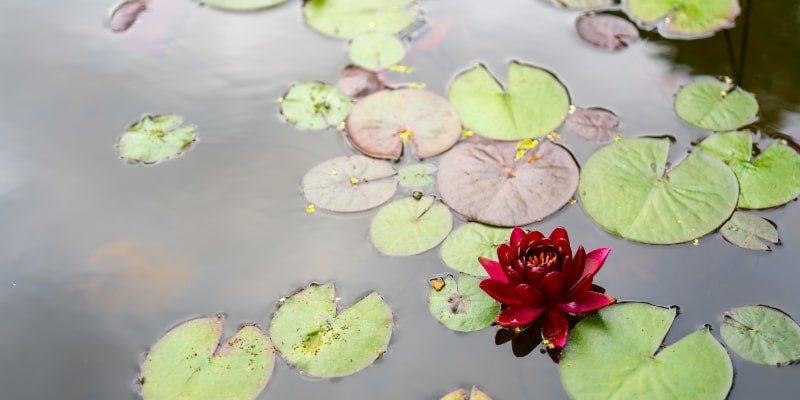 Botanical Name: Nymphaea tetragonal
Botanical Name: Nymphaea tetragonal
Growing Zones: 4-10
Sunlight: Full sun
A perennial aquatic flowering plant of the Nymphaeaceae (water lily) family, Nymphaea tetragona is native to northern Europe and North America.
Floating leaves on these plants support bowl-shaped, many-petaled flowers. Dwarf water lilies have white flowers as their natural colour, but some varieties have brilliant red blooms that look striking as they bob on the water’s surface.
60. Peruvian Lily
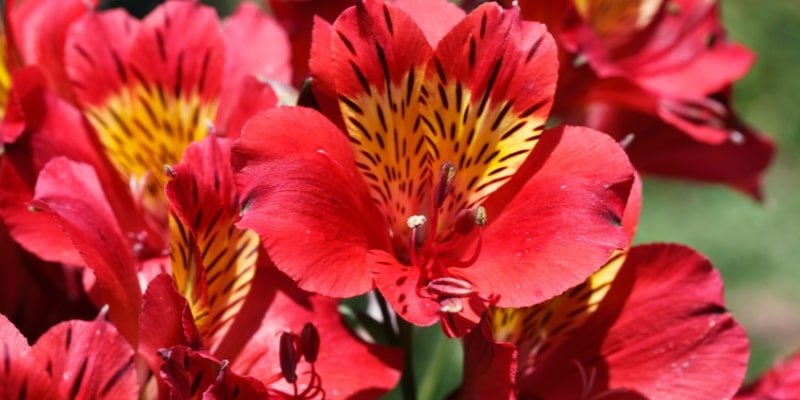 Botanical Name: Alstroemeria
Botanical Name: Alstroemeria
Growing Zones: 7-10
Sunlight: Full sun to partial shade
The Alstroemeriaceae plant family includes the genus Alstroemeria, which is nearly exclusively composed of perennial flowering plants. These plants are also known as the lily of the Incas or Peruvian lily.
Every species in this genus is indigenous to South America; the largest populations are in central Chile and eastern Brazil, respectively. While plants from Brazil go dormant in the winter, those from Chile go dormant in the summer.
Alstroemeria plants that bloom year-round for year-round use in seasonal bouquets benefit florists due to human-directed hybridization between Brazilian and Chilean species.
61. Crown of Thorns
 Botanical Name: Euphorbia milii
Botanical Name: Euphorbia milii
Growing Zones: 9-11
Sunlight: Full sun
Euphorbia milii is a member of the Euphorbiaceae (spurge) plant family and a succulent flowering. The common names for this plant include Christ thorn, Christ plant, and crown of thorns.
Euphorbia milii is believed to have arrived in the Middle East from its native Madagascar far earlier in the history of ancient humans, despite being brought to Europe for the first time in the 1800s. The plant produces blood-red flower bracts surrounding its blossoms and has thickly spiked woody stalks.
62. Tulips
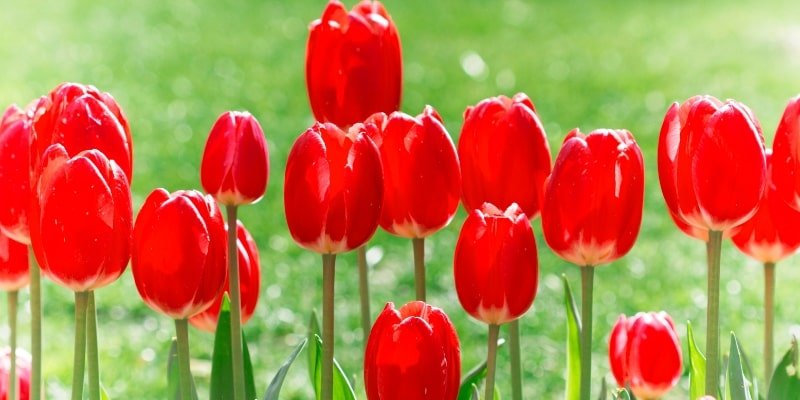 Botanical Name: Tulipa
Botanical Name: Tulipa
Growing Zones: 3-8
Sunlight: Full sun
Tulipa is a genus of perennially blooming plants that grow from bulbs. It is a member of the Liliaceae (lily) plant family and has over 75 species and innumerable cultivars and hybrids.
Tulips are native to an area spanning from southern Europe into central Asia. However, because of their widespread use in trade over millennia, they have now gained naturalization on a worldwide scale. Apeldoorn, red dynasty, and doll’s minuet tulips are a few of the most popular red tulip kinds.
63. Avens
 Botanical Name: Geum
Botanical Name: Geum
Growing Zones: 5-7
Sunlight: Full sun to partial shade
The Geum genus in the Rosaceae family of plants has about fifty species of herbaceous perennial plants. In areas where the temperature does not drop below 0°F, they develop rosettes of ovate leaves that are evergreen.
Flowers bloom in shades of yellow, orange, pink, white, and red. They can be single or have several ruffled double forms. With the apparent exception of Antarctica, they are a common plant on all continents.
64. Sweet Pea
 Botanical Name: Lathyrus odoratus
Botanical Name: Lathyrus odoratus
Growing Zones: 7-10
Sunlight: Full sun
Lathyrus odoratus, sometimes known as the sweet pea, is a fragrant flowering plant in the Fabaceae (legume) family.
Sicily, the Aegean Sea islands, and southern Italy are the native growing regions for sweet peas. Their fragile, grass-like branches support beautiful flowers that can be solid or variegated, ranging in colour from shades of red to almost every colour in the rainbow.
Most famously, sweet peas have a delightfully sweet scent reminiscent of zesty orange blossoms, hyacinths, and roses.
65. Canna Lily
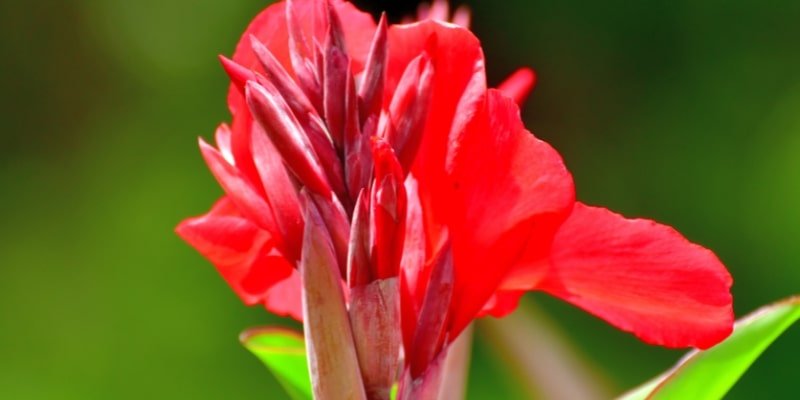 Botanical Name: Canna
Botanical Name: Canna
Growing Zones: 7-10
Sunlight: Full sun
Canna, the sole genus in the Cannaceae family of plants, is home to ten species of flowering plants that are popularly known as canna lilies. These perennial plants spread by clustering together, thanks to their rhizomatic root systems.
Despite growing eye-catching flowers, they are not actually lilies because they are in a separate family of plants. The Americas’ tropical and subtropical regions are their native habitat.
The President, which produces more conventional green foliage, and the Black Knight, which has black foliage, is two popular red cultivars.

